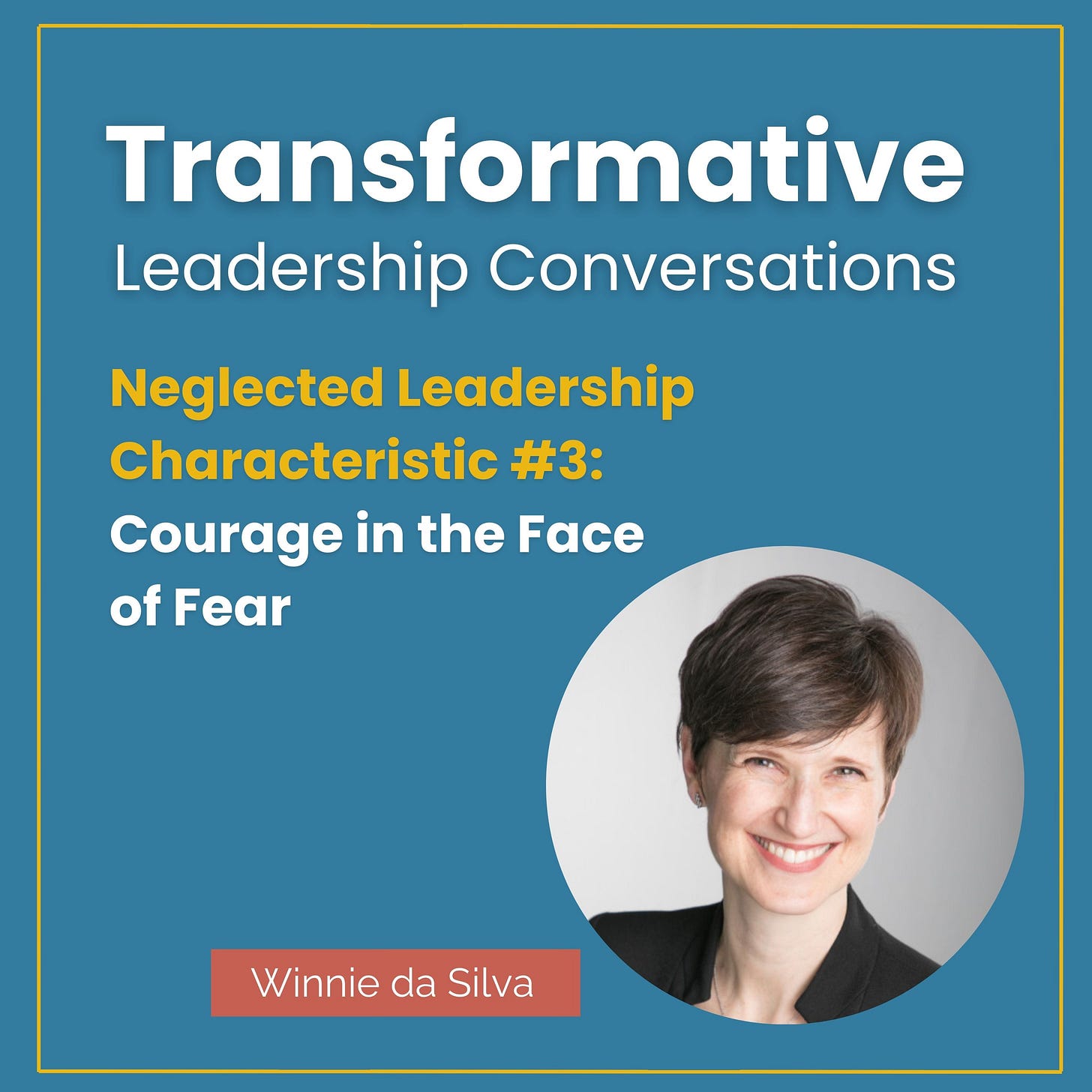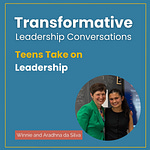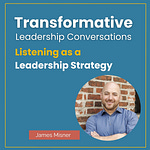
What would your leadership look like if you consistently chose courage over fear?
Let’s be honest—this is not an easy time to be a leader.
Trust in leadership is eroding, uncertainty seems to be everywhere, and the stakes feel higher than ever.
Today, we’re talking about what it means to be courageous in the face of fear. But the real question isn’t just whether you as a leader are courageous. It’s this: what are you using your courage for?
Leadership without courage isn’t leadership at all—but courage without integrity is dangerous.
If you listened to the last two episodes on the show this month, you’ll know we’re pausing the usual format for a different kind of conversation focusing on three essential yet neglected leadership characteristics:
Collaboration through Disagreement
Reframing Humility
Courage in the Face of Fear
Why These Characteristics Matter Today
I started this podcast in late 2020, during a time of fear, disorientation and uncertainty. Now, in 2025, it feels like we’re in another period of fear, disorientation and uncertainty, leading me to ask: What’s my part? One small answer is this solo series on essential yet neglected leadership characteristics.
Rooted in values, these traits define leaders not by what they believe, but by what they do—consistently. Yet, they’re rarely tied to financial outcomes or considered in leadership selection. In uncertain times, prioritizing these overlooked qualities is more important than ever.
From what I see in the news, on social media and in conversations within my community, fear is visible for many of us across our country right now. Fear of being fired. Fear of not being able to provide for our families. Fear of not being able to be yourself. Fear for your friends. Fear for our country.
What fears are shaping your decisions at work right now? What would change if you chose courage instead? And how is fear—whether yours or your team members—impacting your leadership?
Understanding Fear and Courage Using Neuroscience
Over the past 20 to 30 years, our understanding of the brain has advanced dramatically, thanks to technological breakthroughs such as neuroimaging technologies like fMRIs, which allow us to observe brain activity in real time. Let’s explore where fear and courage originate in the brain and how our brains process and interpret fear and courage.
How the Brain Processes Fear
First fascinating fact: your brain registers fear as a threat AND your brain can’t distinguish between a psychological threat and a physical threat!
For example, if you have a fear of public speaking, your brain processes that fear as if you were being chased by a lion in the jungle.
To understand how this happens, let’s break the brain down into three key areas:
The Reptilian Brain – Located at the brainstem, this is the most primitive part of the brain. It controls essential survival functions like our heartbeat, breathing, body temperature, and balance—things we don’t consciously think about but are vital to staying alive.
The Limbic System – Often called the emotional center of the brain, the limbic system plays a key role in processing emotions, forming memories, and driving instinctual behaviors. It’s the part of your brain that reacts before you consciously think, and it plays a major role in fear and courage – we’ll come back to this in a minute.
The Prefrontal Cortex – By far the biggest and most advanced part of our brain, this is where our executive functioning takes place. It controls planning, decision-making, our working memory, impulse control, and emotional regulation.
Now let’s introduce fear into this complex brain system. First the amygdala (located in the limbic system) is constantly scanning our environment to ensure our safety. Just one stray sound or movement—BOOM— your amygdala detects it, and alarms are on high alert! Our brains immediately interpret any type of warning signal as a potential physical threat, triggering our stress response.
But here’s the problem: when the amygdala senses danger, it literally hijacks our prefrontal cortex—which if remember, is the part of our brain responsible for thinking clearly, regulating emotions, and making decisions.
Why? Remember your brain interprets every threat as a physical one, and in a crisis, there’s no time to think—only time to react. Your brain is taking immediate action in preparing your body to fight, take flight or to freeze.
This is great if you’re facing a life-or-death situation, but not so helpful when you’re making a tough decision or having a difficult conversation. This stress response kicks in automatically, shutting down your ability to think logically—before you even realize what’s happening.
Your brain is wired to protect you first and think later. But the good news? You can learn to override this response—more on that in a minute.
Second fascinating fact: there is a specific region in your brain where you can actually see courage at work!
Neuroscientist Daniela Schiller conducted a study to explore what happens in the brain when people confront fear in real time. You can read more about it in this article, "Snakes in the MRI Machine: A Study of Courage." It sounds like we’re talking about some crazy movie - but this is real!
Participants who had a fear of snakes were placed inside an MRI scanner, lying on their backs while a live snake was positioned directly behind their head on a movable platform. A mirror was placed in front of them, allowing them to see the snake without physically turning around.
THEN each participant was given a remote control and had to decide—move the snake closer to their head or push it farther away.
This setup allowed researchers to observe their brain activity as they actively chose to confront or avoid their fear.
The results were eye-popping. When participants opted to move the snake closer—demonstrating an act of courage—there was increased activity in the subgenual anterior cingulate cortex (sgACC). Not surprisingly, this part of the brain is found in our prefrontal cortex – that very same area where we make decisions, regulate emotions, and assess risks and rewards.
Even more fascinating, when participants voluntarily moved the live snake closer to their heads – effectively an act of courage – researchers could see decreased activity in the amygdala, which is located in the limbic system – the part of the brain responsible for processing fear.
This tells us something powerful. Courage isn’t the absence of fear; it’s the ability to override it.
Instead of waiting for fear to disappear, courageous leaders can learn to act despite it, using their prefrontal cortex to guide their decisions rather than letting fear take control. Courage isn’t just a mindset—it’s a physiological process.
Your brain has a built-in mechanism that allows you to push through fear. While our brains are wired to fear, leadership demands that we choose courage anyway.
Why Courage in Leadership Matters Now More Than Ever
The stakes for leaders are always high. And often, courage in leadership isn’t lacking because it’s unimportant—it’s lacking because the risks feel too great.
Taking a stand can jeopardize job security, reputation, and financial stability, making it easier for leaders to avoid fear rather than confront it. Courage also demands significant mental and emotional energy. Challenging the status quo can create friction. But real leadership isn’t about avoiding conflict—it’s about stepping up, even when it’s uncomfortable or risky.
Here are a few ways being courageous in the face of fear is challenging for leaders today
1. Complexity & Speed
The pace of technological advancements, economic shifts, and global challenges is forcing leaders to make tough decisions with incomplete information. The right path is often unclear, yet the pressure to make decisions quickly continues to rise.
2. Transformative Technology
Technology isn’t just advancing—it’s leapfrogging ahead, radically reshaping how we think and work, and in some cases taking over our jobs! The speed of innovation can feel overwhelming, as industries evolve faster than individuals or organizations can adapt.
3. Close Yet Far
The world today is more connected than ever. We have instant access to global events, and their ripple effects feel closer and more immediate than in the past. Yet paradoxically, at a local level, we are more isolated and divided—whether it’s ideological or physical. Work may be one of the few places where people with different backgrounds, perspectives, and experiences come together.
4. Your Vales at Work
More than ever, people are reflecting on their values and questioning whether they align with their workplace culture. Do my values match those of my company? Do I have room to influence and shape the culture, or am I in an environment where that’s not possible? To address any of these questions require courage.
Ultimate Courage in the Face of Fear
When I considered workplace examples of courage in the face of fear, whistleblowers immediately came to mind.
A whistleblower is someone who speaks up when they see wrongdoing inside an organization; whether it’s fraud, corruption, safety violations, or unethical behavior. They might report it internally, to regulators, or even to the public, often at great personal risk. By calling out these issues, whistleblowers push for accountability and help create a fairer, more transparent workplace and society.
But it takes serious courage to stand up to powerful organizations, especially when it could end your career. While whistleblowers may face backlash, history has shown that they have been the catalyst for real change.
Breaking the Silence on Purdue Pharma
When Steven May joined Purdue Pharma in 1999 as a sales representative, he believed in its mission. OxyContin was marketed as a breakthrough—a long-lasting painkiller with a low risk of addiction. That’s what he was trained to believe. That’s what he told doctors. And that’s what he thought was true.
But over time, the cracks became impossible to ignore. Sales quotas kept rising, doctors were urged to prescribe higher doses, and Purdue downplayed the growing reports of addiction. Patients who had been prescribed OxyContin for minor injuries were becoming dependent. Overdose deaths surged. Between 1999 and 2010, opioid-related fatalities in the U.S. nearly quadrupled, and Steven saw firsthand how Purdue’s aggressive marketing was fueling the crisis.
He watched as the company doubled down instead of pulling back. Purdue told doctors that signs of addiction weren’t red flags—they were proof that pain needed stronger treatment. Instead of cutting doses, physicians were told to increase them. The company targeted high-prescribing doctors, even those with questionable medical practices, ensuring OxyContin flooded communities across the country. Sales reps were rewarded financially for pushing more prescriptions, fueling a cycle of overprescription, addiction, and death.
After leaving Purdue, the weight of what he had seen stayed with him. He had witnessed how profit was prioritized over lives, how patients were misled, and how doctors were manipulated. Walking away didn’t erase that knowledge—or his conscience. He knew speaking out could cost him his career, reputation, and financial stability. But staying silent meant being complicit. He had to act.
Determined to expose the truth, he filed a federal lawsuit against Purdue, revealing the company’s deceptive marketing practices. He detailed how sales reps were trained to downplay addiction risks, Purdue ignored clear signs of abuse, and the company encouraged higher doses instead of safer alternatives—all to maximize profits. His decision to become a whistleblower placed him at the center of a growing storm—one that would eventually bring Purdue under scrutiny.
The case was dismissed on a technicality, a frustrating end to a fight he had risked so much for. But that wasn’t the end of his impact. His voice helped bring more scrutiny to Purdue’s practices, adding fuel to a fire of investigations, lawsuits, and public outrage. Years later, reports would expose how consulting firm McKinsey & Company advised Purdue on ways to “turbocharge” OxyContin sales—including offering rebates for overdose-related prescriptions. The groundwork for accountability had been laid by people like Steven, who had the courage to speak up.
Purdue Pharma would eventually face criminal charges, pleading guilty in 2020 to misleading the public about OxyContin’s risks. The company reached an $8.3 billion settlement, and the Sackler family agreed to pay billions more to settle civil cases. Meanwhile, McKinsey settled for $650 million in 2024 for its role in the crisis. But these victories came too late for the hundreds of thousands who lost their lives to opioid addiction.
Being a whistleblower didn’t come with a hero’s welcome. But in a world where fear keeps people silent, courage is what breaks the cycle. Steven May made the choice to stand up, knowing the cost, and because of that, the truth came to light.
(To learn more, check out these resources: How OxyContin Was Sold to the Masses, Former Purdue Pharma sales rep turns whistleblower, McKinsey & Company agrees to pay $650M for helping Purdue Pharma boost opioid sales)
Becoming Courageous in the Face of Fear at Work
Mark Twain once said, “Courage is resistance to fear, mastery of fear—not absence of fear.”
Courage isn’t just something we have or we don’t—it’s a skill that can be developed. Neuroscience shows that by understanding how our brains respond to fear, we can train ourselves to override automatic reactions and make braver choices. Here’s how:
1. Identify Where Fear Is Holding You Back
Where have you been avoiding action—giving tough feedback, making a bold decision, or standing up for what’s right? Maybe it’s a difficult conversation with a colleague, a change you know your organization needs, or a risk that feels too big to take. Recognizing where courage is needed most is the first step toward acting on it. If you don’t define where fear is limiting you, you can’t push past it.
2. Reframe Fear as Data, Not a Stop Sign
Fear is a natural response, but instead of automatically retreating, view fear as information. Pause to assess and reflect on this data. Engage your prefrontal cortex so you can think and make intentional decisions with clarity.
3. Take Small, Intentional Steps
Courage isn’t always about making grand gestures. Courage can also be about making consistent, small actions that train your brain to overcome fear. Like in the Snakes in the MRI Machine study, each time you face fear head-on, you prove to yourself that you can do it. Start by taking one small step—having a difficult conversation, voicing a concern, or simply acknowledging the fear instead of pushing it aside. Courage compounds with practice.
4. Lean on the Right People
Courage isn’t always a solo act. Look for allies, mentors, or trusted colleagues who can offer perspective, advice, or support. Perhaps build a coalition or get key people on board before making a bold move. Do you know of others who have faced a similar challenge? What can you learn from them?
5. Prepare for the Risks—Then Act Anyway
Courage isn’t the absence of risk—it’s taking action despite uncertainty or fear. Pushback, tough conversations, or professional consequences may come, but preparation makes them easier to navigate. Think through what’s in your control, anticipate challenges, and have a plan—but don’t let the need for certainty keep you from moving forward. At some point, you have to step into action and trust that you’re ready.
The Bottom Line: Courage is a Leadership Choice
Courage isn’t about eliminating fear, it’s about learning to navigate it.
The more you practice, the stronger your ability to become a more courageous leader. Courage isn’t just a mindset, it’s a physiological process, something we can train and strengthen over time. It’s not the absence of fear, but the choice to move forward in spite of it.
Use these questions to consider your own leadership:
What’s the cost of NOT acting courageously in your leadership right now?
If fear weren’t a factor, what courageous decision would you make today?
Who on your team needs you to model courage right now?
Because at the end of the day, the real question isn’t whether you feel fear—it’s what you do next.
You're always welcome at the table, where every discussion has the potential for transformative change.















Share this post